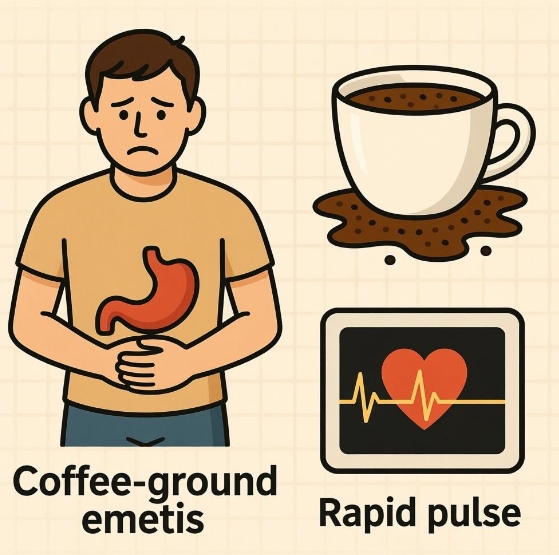Upper gastrointestinal bleeding refers to hemorrhage originating from any site between the mouth and the ligament of Treitz. It ranges from trivial ooze noticed only on laboratory testing to catastrophic, life-threatening exsanguination. Rapid recognition of its varied presentations allows timely resuscitation and definitive hemostasis.
- Key visual clues
• Hematemesis: vomiting fresh red blood or clots indicates active, usually arterial, bleeding; when gastric acid mixes with blood for minutes the appearance becomes “coffee-ground.”
• Melena: black, tarry, foul-smelling stool that sticks to the toilet bowl; at least 50 mL of blood in the upper tract is needed to produce this change.
• Nasogastric aspiration: bloody return confirms ongoing bleeding; clear bile-stained fluid makes a proximal source unlikely but does not exclude duodenal hemorrhage. - Volume-related symptoms
• Postural dizziness or syncope when standing: suggests ≥15 % circulating volume loss.
• Resting tachycardia (>100 beats/min) and orthostatic drop (>20 mmHg systolic) are early compensatory signs.
• Hypotension, cold clammy extremities, and delayed capillary refill mark hemorrhagic shock (>30 % loss).
• Oliguria and confusion follow if mean arterial pressure remains below 65 mmHg. - Subtle or chronic presentations
• Iron-deficiency anemia: fatigue, pallor, brittle nails, or pica in patients denying overt blood loss; may be the sole clue to a slowly bleeding gastric neoplasm.
• Occult positive fecal immunochemical test in an otherwise asymptomatic individual undergoing screening. - Associated features pointing to specific etiologies
• Epigastric pain relieved by food: peptic ulcer.
• Profuse retching followed by longitudinal mucosal tear: Mallory-Weiss syndrome.
• Severe hematemesis in a patient with cirrhosis, spider nevi, or ascites: variceal rupture.
• Projectile non-bilious vomiting in an infant: pyloric stenosis with mucosal erosion.
• Recent heavy aspirin, clopidogrel, or anticoagulant use: drug-induced erosive gastropathy. - Immediate red-flag combinations
Syncope plus coffee-ground emesis, hematemesis with systolic blood pressure <90 mmHg, or melena accompanied by rising creatinine and falling urine output mandate emergency activation of bleeding protocols.
Summary table
复制
| Sign/Symptom | Typical volume loss | What to do next |
|---|---|---|
| Coffee-ground vomitus | 100–300 mL | Urgent gastroscopy within 24 h |
| Fresh hematemesis with clots | >500 mL often | Large-bore IV, cross-match 4–6 units, consider ICU |
| Melena without shock | 50–200 mL | Monitor vitals every 30 min, Hb at 6 h intervals |
| Orthostatic drop | ≥15 % | Rapid crystalloid, consider transfusion trigger Hb <70 g/L |
| Syncope, hypotension, tachypnea | ≥30 % | Activate massive transfusion protocol, airway protection |
